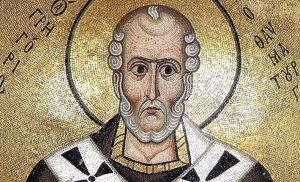 After his education, Gregory married and became a teacher of rhetoric. We do not know what happened to his wife, but the influence of his older brother Basil was strong enough to draw Gregory to monastic life. In 371, Basil arranged for his election as bishop of Nyssa, a town in Basil’s province. It was a political move intended by Basil to stem the influence of the Arians. Gregory was not happy with this sudden thrust into the fray, and he was not a very effective ally, and his brother criticized him for his lack of firmness. In the following decade he was deposed by the Arians, and later restored. His brother died, and Gregory came into his own. he was a prominent participant in the 2nd Ecumenical Council. He wrote scriptural commentaries and spoke of the concept of theosis, or deification as a luminous darkness, the ultimate paradox of union with God. His mystical theology is an early expression of the apophatic method which places more certainty in what we cannot say or know about divine truths. (NS)
After his education, Gregory married and became a teacher of rhetoric. We do not know what happened to his wife, but the influence of his older brother Basil was strong enough to draw Gregory to monastic life. In 371, Basil arranged for his election as bishop of Nyssa, a town in Basil’s province. It was a political move intended by Basil to stem the influence of the Arians. Gregory was not happy with this sudden thrust into the fray, and he was not a very effective ally, and his brother criticized him for his lack of firmness. In the following decade he was deposed by the Arians, and later restored. His brother died, and Gregory came into his own. he was a prominent participant in the 2nd Ecumenical Council. He wrote scriptural commentaries and spoke of the concept of theosis, or deification as a luminous darkness, the ultimate paradox of union with God. His mystical theology is an early expression of the apophatic method which places more certainty in what we cannot say or know about divine truths. (NS)
Author: Paul Zalonski
St Andre Bessette
Epiphany
 “Stars cross the sky, wise men journey from pagan lands, earth receives its savior in a cave. Let there be no one without a gift to offer, no one without gratitude as we celebrate the salvation of the world, the birthday of the human race. Now it is no longer, Dust you are and to dust you shall return, but “You are joined to heaven and into heaven you shall be taken up.”
“Stars cross the sky, wise men journey from pagan lands, earth receives its savior in a cave. Let there be no one without a gift to offer, no one without gratitude as we celebrate the salvation of the world, the birthday of the human race. Now it is no longer, Dust you are and to dust you shall return, but “You are joined to heaven and into heaven you shall be taken up.”
St. Basil the Great
Feast of the Epiphany
How do I want to live my life?
At the beginning of a new year the following words of Father Alexander Schmemann give us much to think about:
“…What then gives meaning to a particular day, to the TODAY we live in? Is it not simply one day out of a long sequence of days that each one of us has to live through? Yet for me, as a Christian, its new and deep meaning comes from the past. It is a day related to Christ’s coming into the world, a day AFTER His coming, and thus the Christian is the one who first of all, REMEMBERS. He can forget Christ; he can wake up in the morning and think only of the petty concerns of that particular day, yet, on a deeper level, even these minor concerns become a very different experience if he remembers that he is not simply John Smith who has to do this or that, but the one to whom Christ has come, whose life Christ has assumed and has given new meaning. “Today,” however, has a second meaning, because it is also a day BEFORE Christ’s return. Thus I am always living between the two comings of Christ: the one in the past, the other in the future. And finally, the meaning of TODAY comes to me from the words of Christ, who says that He is ALWAYS with me. “And lo, I am with you always, to the close of the age” (Mt 27:20). Past, present, future – we see that the time in which we live is not only the time of the calendar, but the time that is shaped from inside and transformed by faith, by Christian experience. It is related to the coming of Christ in the past, to His coming in the future, and to His presence now…”
Virgin Mary gets a bad rap, sometimes
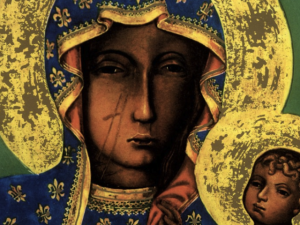 On this first day of the new calendar year, the Novus Ordo Catholic Church celebrates the feast of Mary, the Mother of God. It is, in fact, the 8th day since the Incarnation and traditionally the Church recalls the Lord’s adherence to the Divine Law with his circumcision.
On this first day of the new calendar year, the Novus Ordo Catholic Church celebrates the feast of Mary, the Mother of God. It is, in fact, the 8th day since the Incarnation and traditionally the Church recalls the Lord’s adherence to the Divine Law with his circumcision.
I’d like to highlight something we tend to overlook in our daily journey of faith. That is, the role of Mary, the Mother of God and the Mother of us all, in this walk of faith. What does Mary teach us? Why is she so very critical to our catholic life? Recall, the Church has some central themes in her theology that we need to attend to, namely, the Church is approached from the perspective of the Marian dimension in light of our discipleship.
Some friends wrote the following reflection on Mary that I think needs to be more widely seen and understood:
Sometimes in Christian spirituality, the Virgin Mary gets a bad rap because she is so routinely associated with a damaging and suffocating sentimentality, something sickeningly sweet. But this is really a fiction; the Gospel’s portrait of her reveals something entirely different. There we encounter a Mary who is so open to the Word of God that she actually gives birth to it. At the same time, I believe she knew what it meant to encounter the Lord in the darkness of faith. Can we imagine what it must have been like to learn that she was to give birth to the Messiah? Can we imagine her inner struggle, wondering if this could actually be? And yet, her simple “fiat” is what Jesus commands in this morning’s Gospel. “Blessed rather, are they who hear the word and keep it.” In Mary we discover one who not only heard the Word, she “digested” it; she expressed the whole message of the scriptures in her life. We’re told in several places that Mary “treasured these things, and pondered them in her heart.” That was her fundamental attitude. In a very real sense, she is the archetype of a disciple, of what it means to be a follower of Christ. (NS)
Blessings in 2018!!!!
Holy Family is the model
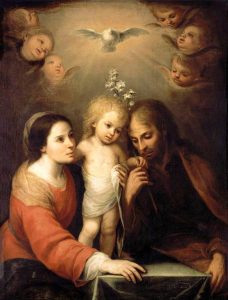 “The Holy Family is an icon of the domestic Church, which is called to pray together. The family is the first school of prayer where, from their infancy, children learn to perceive God thanks to the teaching and example of their parents. An authentically Christian education cannot neglect the experience of prayer.
“The Holy Family is an icon of the domestic Church, which is called to pray together. The family is the first school of prayer where, from their infancy, children learn to perceive God thanks to the teaching and example of their parents. An authentically Christian education cannot neglect the experience of prayer.
If we do not learn to pray in the family, it will be difficult to fill this gap later. I would, then, like to invite people to rediscover the beauty of praying together as a family, following the school of the Holy Family of Nazareth.”
Pope Benedict XVI
Holy Innocents
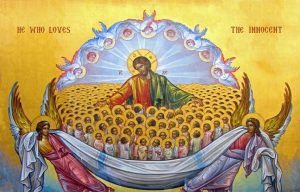 Today, in the days following the feast of the Incarnation, we honor the memory those who were among the first to die as martyrs for faith in Jesus Christ. It is amazing that 2000 years ago we had very young people, innocents, killed due to sin and hardness of heart. The feast day for the Holy Innocents marks the martyrdom of an unnumbered group of boys aged 2 and under during the reign of King Herod. The murder of these young boys fulfills the prophecy of St Jeremiah:
Today, in the days following the feast of the Incarnation, we honor the memory those who were among the first to die as martyrs for faith in Jesus Christ. It is amazing that 2000 years ago we had very young people, innocents, killed due to sin and hardness of heart. The feast day for the Holy Innocents marks the martyrdom of an unnumbered group of boys aged 2 and under during the reign of King Herod. The murder of these young boys fulfills the prophecy of St Jeremiah:
Then was fulfilled that which was spoken through Jeremiah the prophet, saying, ‘A voice is heard in Ramah, mourning and great weeping, Rachel weeping for her children and refusing to be comforted, because her children are no more.’ (Jer 31:15)
They did not die on account of their own personal misdeeds; a confession of faith was not required of them. Why did they die? We don’t know; that answer is known to God alone; but we trust that their eternal life is better than any life they had on earth; happiness, and beatitude. We know that they died in retaliation in Herod searching out competition. And Jesus was that competitor. As the Latin hymn says, Crudelis Herodes, Deum Regem venire quid times? Non eripit mortalia, Qui regna dat caelestia (Cruel Herod what do you fear in the King and God to come? He seizes not earthly things who gives heavenly kingdoms). Indeed, it IS his fear that drives Herod.
In our own era we have similar deaths of innocents –while not laying their lives down for Jesus in the same way, but violent and egregious nonetheless with the victims of abortion. Plus, we can’t forget the children plagued with human trafficking and domestic violence. Some young people are trafficked for sex, forced labor, immigration and war. Nonetheless, the killing of babies and the very young is unbelievable.
What does this all mean for our prayer and mission? Pope Francis said last year on this feast day: “To contemplate the manger also means to contemplate this cry of pain, to open our eyes and ears to what is going on around us, and to let our hearts be attentive and open to the pain of our neighbors, especially where children are involved.”
Archpriest David Petras wrote, “The holy innocents are only the first of thousands upon thousands who will have to die for the spiritual kingdom of God. God does not oppose the violence of this world with weapons or an army, but he calls upon all to hear the truth and to love and not hate. This part of the Christmas gospel may make us extremely uncomfortable – almost by definition, but it reminds us of the struggle faith will have in this world, and that every Christian must be prepared to offer his or her life for God.”
On this feast of the Holy Innocents during the Octave of the Nativity, the Christ Child and the innocents have something definite to teach us: that we are to protect human life at this very tender stage. In honoring these little ones we also reflect upon the need for our atoning for forgetting about the deaths of these youths. May the intercession of the Holy Innocents be with those in need, with all of us.
God’s mercy reaches us
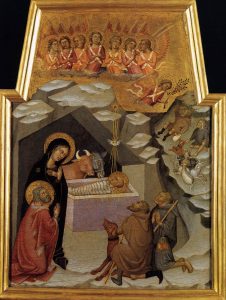 Let Your goodness Lord appear to us, that we,
Let Your goodness Lord appear to us, that we,
made in your image, conform ourselves to it.
In our own strength
we cannot imitate Your majesty, power, and wonder
nor is it fitting for us to try.
But Your mercy reaches from the heavens
through the clouds to the earth below.
You have come to us as a small child,
but you have brought us the greatest of all gifts,
the gift of eternal love
Caress us with Your tiny hands,
embrace us with Your tiny arms
and pierce our hearts with Your soft, sweet cries.
a Christmas Prayer attributed to Saint Bernard
St Peter Canisius
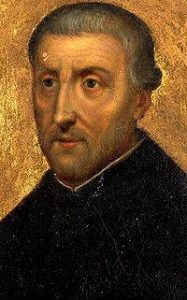 “At length, it was as if you [Lord] opened to me the heart in your most sacred body: I seemed to see it directly before my eyes. You told me to drink from this fountain, inviting me, that is, to draw the waters of my salvation from your wellsprings, my Savior. I was most eager that streams of faith, hope and love should flow into me from that source. I was thirsting for poverty, chastity, obedience. I asked to be made wholly clean by you, to be clothed by you, to be made resplendent by you.”
“At length, it was as if you [Lord] opened to me the heart in your most sacred body: I seemed to see it directly before my eyes. You told me to drink from this fountain, inviting me, that is, to draw the waters of my salvation from your wellsprings, my Savior. I was most eager that streams of faith, hope and love should flow into me from that source. I was thirsting for poverty, chastity, obedience. I asked to be made wholly clean by you, to be clothed by you, to be made resplendent by you.”
St Peter Canisius, pray for us.
Rosary Priest moves ahead in sainthood study
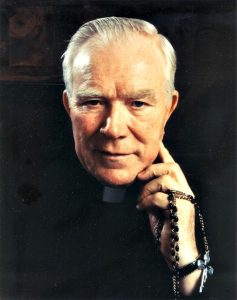 On 18 December 2017, the Holy Father received Cardinal Angelo Amato, S.D.B., Prefect of the Congregation for the Causes of Saints, and among the decrees issued was this one on the cause for canonization of Father Patrick Peyton. The notice reads:
On 18 December 2017, the Holy Father received Cardinal Angelo Amato, S.D.B., Prefect of the Congregation for the Causes of Saints, and among the decrees issued was this one on the cause for canonization of Father Patrick Peyton. The notice reads:
The heroic virtue of the Servant of God Patrick Peyton, a priest of the Congregation of Holy Cross. He was born January 9, 1909 in Carracastle (Ireland) and died in San Pedro, California, on June 3, 1992.
The Venerable Servant of God Father Patrick Peyton was founder of the Holy Cross Family Ministries, dedicated his life to serving God by bringing a message of hope to families around the world and encouraging family prayer of the rosary.
Blessed be God
